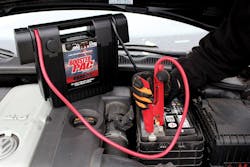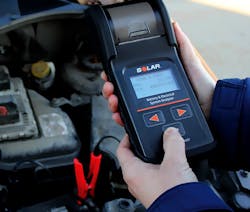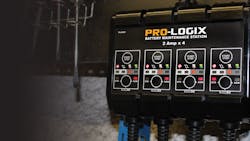Enhanced flood batteries: How to handle these in the shop
Enhanced Flooded Batteries (EFB) first saw widespread deployment in North American vehicles in 2018, as vehicle manufacturers looked for cost effective alternatives to AGM batteries for Start-Stop system deployment. Their usage has grown over the past seven years to the point where they are a significant technology for shops and vehicle owners to manage.
According to a recent article on Motor.com, “Market research shows that in 2024, approximately 12.5 million vehicles on U.S. roads are equipped with EFBs. By 2030, that number is projected to reach 25 million—nearly 10 percent of the total fleet.” A recent study published by Battery Council International (BCI) references the strong growth of EFB batteries as well: “Within the automotive lead battery sector, there’s been strong growth in absorbent glass mat batteries (AGMs) and extended range flooded batteries (EFBs)…”
What does this mean for today’s shops? As the Motor.com article points out, EFB-equipped vehicles are reaching critical mass among vehicles in the “aftermarket sweet spot.” This means that they’re showing up in service bays across the country in larger quantities and are no longer just seen in dealerships and collision repair. What should shops know about servicing these batteries, in terms of starting, charging, testing and maintaining them? Are there safety implications when servicing them? Are there performance issues and implications if handled incorrectly?
First things first — What is an Enhanced flooded battery (EFB)?
There are many EFB definitions, but we’ll start with the definition used by BCI: “An EFB is a vented (flooded) lead-acid starter battery with additional design features to significantly improve the cycling capability and service life compared to standard flooded batteries, especially for start-stop vehicle applications.”
Here is how we described them in a previous article on EFB testing: they are a new type of flooded battery that has several differences in their design and construction that allow them to be used in new vehicle applications. Per the battery manufacturer Yuasa, some of these construction changes include “increased dynamic charge current acceptance over standard wet-flooded batteries (+170 percent), due to improved design including special carbon additives and high charge acceptance envelope type separators.”
To further clarify, the critical things to know about these batteries is that they are:
a.) A variant of the flooded battery,
b.) feature improved construction details that allow them to stand up to deeper discharging than traditional flooded batteries
c.) were specifically developed for use in vehicle Start-Stop systems, and
d.) are most cost-effective than equivalently powered AGM batteries.
As we will see below, one of the key things to know is that, although they have the term “Flooded” in their name, they often need to be treated like their own class of battery when it comes to diagnosing and servicing them.
The easy part — jump starting
As we have noted in past articles, mixed battery jump starting (AGM lead acid on lithium, lithium on AGM lead acid, etc.) doesn’t cause issues as long as you follow the key tenants of jump starting: 1.) always match voltage (12V to 12V, etc.), 2.) wear safety gear, 3.) follow manufacturer’s instructions and 4.) negative always goes to ground.
Otherwise, the jump starter battery type can be of any variety, since, when jump starting, you are essentially augmenting the vehicle’s starting battery via a true DC-DC connection. When jump starting, you aren’t pushing energy into the vehicle or the vehicle’s battery. So, if your vehicle is equipped with a Start-Stop system that utilizes an EFB battery, you can use virtually any (voltage-compatible) jump starter to get it started.
Semi-complicated — battery testing
This one really isn’t too complicated, assuming that you’re using quality test equipment. It can be boiled down to one overarching rule: If you are using a digital battery tester to test EFB batteries and want an accurate assessment, your digital battery tester needs to have a specific test setting for EFB batteries.
This stands to reason. The internal construction of an EFB battery is fundamentally different than that of a traditional flooded lead acid battery. As such, it is going to react very differently to the pulse of energy sent through it by the digital tester. So, it requires a specific judgement map in order to accurately assess how that reaction happens. If you tried to use the standard flooded lead acid judgement map, even a compromised EFB battery could look healthy.
The good news here, as we have pointed out previously, is that our BA Series Digital Battery and System Testers feature an EFB-specific test setting. For testing EFB batteries using our printer-equipped models (BA227, BA327), when the tester prompts to input battery type, toggle to START STOP and press ENTER. Then, toggle to EFB and press ENTER, following the prompts to complete the process. For testing EFB batteries using the BA9, when the tester prompts to input battery type, toggle to SSEFB, following the prompts to complete the process. It is really that simple. The tester will run its analysis and provide an accurate assessment of EFB battery condition, based on the input values provided. It’s that easy with BA Series!
With regard to invasive testing, since these testers typically do not distinguish between battery types, EFB batteries are tested as any other battery would, using the BCI test standard. So, carbon pile testing is very straight forward for this battery type.
The fuzzy logic — Charging and maintaining
As is often the case with newer battery types, there is a lot of conflicting information out there when it comes to charging EFB batteries. Some information sources suggest charging them like standard flooded lead acid batteries while others suggest charging them in the AGM charge setting is best. This reminds us of the early days of AGM and Spiral Wound AGM batteries, where we got all kinds of answers, including flat-out incorrect answers in the booth of one very large Spiral Wound AGM battery manufacturer.
After much research, we have concluded that the best answer when it comes to charging EFB batteries is to charge them using the AGM setting when using our PRO-LOGIX or CHARGE IT! battery chargers. This is because the EFB construction is more sensitive to voltage than a traditional flooded battery is. Like the AGM battery type, with EFB, it is important not to exceed recommended bulk charging and absorption charging voltage limits.
As a for instance, the team at Stryten Battery, a major provider of EFB batteries to OEs and the aftermarket, recommends not allowing bulk charge to exceed 14.8V and switching to absorption charging at that point. They recommend holding absorption charge voltage at 14.8V. These instructions are similar to the charging instructions for charging AGM batteries – this is why we recommend using the AGM setting when charging EFB batteries.
Like AGM batteries, EFB batteries are sensitive to temperature and to excessive ripple when charging. The good news is that PRO-LOGIX battery chargers feature temperature compensation to account for changes in the way these batteries accept charging energy at different temperatures. Similarly, with extremely low ripple in their energy delivery, PRO-LOGIX chargers provide beneficial service to newer AGM, Spiral Wound, EFB and LiFePO4 lithium types. In essence, the features that make PRO-LOGIX great for AGM battery service also make PRO-LOGIX great for EFB service.
We hope that these service tips are useful to you as you encounter an ever-increasing number of EFB batteries in your service operation. Like the AGM battery before it, it is important to have your service gameplan ready when one of these rolls into your bay and, as always, it is critical to have quality service equipment on hand to make quick work of these batteries, whether for jumping, testing or charging.
About the Author

Jim O' Hara
Clore Automotive
Jim O'Hara has over 15 years experience in the Tool and Equipment industry, including 10+ years at Clore Automotive. At Clore, he heads up the marketing team and is directly involved in the development of new products and enhancements of existing products.



